


|

|
|
|
|
Roadmap for Creating Promotional Campaigns
This topic describes the high-level process or roadmap you should follow when creating a new promotional campaign in the BEA E-Business Control Center. Following this process will help ensure the best possible delivery of targeted information to your online customers, and reduce your risk for errors when using the application. Where relevant, this topic contains references to other documentation that provides step-by-step instructions for executing the tasks described, or to documentation that provides more details about a concept.
This topic contains the following sections:
Introduction
Most promotional campaigns conceived within your organization will be developed within the context of a strategic business objective. For example, you may want to run campaigns aimed at increasing your average order size by employing cross-sell or up-sell tactics. However, you can also use campaigns on internal Web sites. For example, your Human Resources department can set up an employee portal and use campaigns to encourage employees to sign up for specific benefits.
As you define your overall campaign objective, you will need to answer the following core marketing questions:
The answers to these questions relate directly to how you will set up your promotional campaign using the E-Business Control Center. The remaining sections in this roadmap provide guidance for developing your promotional campaigns.
Examples of Campaign Types
This section provides examples of campaigns that are designed to fulfill different types of business objectives:
Combining Campaigns with Discounts to Sell Products
If you use WebLogic Portal and you want to target discounts for specific segments of your customers, you can use a campaign to do the following:
For example, you want to entice professional carpenters who buy circular saws from your e-commerce Web site to buy saw blades as well. When a customer logs in, WebLogic Portal determines if the customer is in your ProfessionalCarpenter customer segment. If so, and the customer places a circular saw in the shopping cart, then the shopping cart displays an ad for a 50% discount on saw blades. The customer places the saw blades into the shopping cart and receives the discounted price.
Generating Revenue with Ad Clickthroughs
If your business generates revenue by advertising products, you can use a campaign to do the following:
For example, Jan's Roasted Coffee contracts with you to advertise their french roast blend during the month of August. They pay 5 cents for each ad display (impression) and 1.5 cents for each ad clickthrough up to $2000.
To try to maximize the number of ad clickthroughs, you run a test campaign to determine which customers are most likely to respond to the Jan's Roasted Coffee ad and at what times of day the ad clickthroughs are most likely to occur. Your campaign analysis shows that adult females respond to advertisements for Jan's Roasted Coffee between the hours of 6 a.m. and 9 a.m. Using this information, you can create a campaign to target ads to an AdultFemale customer segment during the specified hours. Since your contract with Jan's Roasted Coffee is during the month of August, you can set up the campaign to begin displaying coffee ads on August 1st and stop displaying them on September 1st.
Notifying Employees of New Benefits
If you use WebLogic Portal for your internal Web site, you can use a campaign to encourage your employees to log in to your human resources portal and sign up for a new benefit.
For example, the ACME insurance company creates a new alliance with a health care provider network in New England. You can use a campaign to send e-mail to all employees who live in New England and use the ACME insurance company. When the employee logs in to your internal Web site, you can also display ads for health care seminars that are available to your New England employees.
Creating Customer Segments
When you have answered the question, "Which group of customers do I want to include in my campaign?", you will be ready to create one or more customer segments in the E-Business Control Center.
A customer segment is a grouping of customers based on common characteristics from their customer profiles, such as age, occupation, product preferences, and the amount of purchases they have made; or a grouping of customers you want to communicate with or target with your marketing campaigns. A customer segment can also be identified in the E-Business Control Center by visitors who log in on specific dates or times, or by visitors whose HTTP session or request information matches properties you set up in the E-Business Control Center Session and Request tools.
As part of creating your promotional campaigns, one of the first things you will need to do is to create customer segments. Once you create a customer segment, the customer segment can be reused in any number of campaigns, whenever you feel it is relevant to your campaign objective.
For More Information
Using Scenario Templates
Out of the box, the E-Business Control Center provides you with four scenario templates that you can modify to quickly create scenarios that are meaningful for your promotional campaigns. The goal of these scenario templates is to provide useful, easily applicable, and time-saving templates for reuse, and to illustrate more advanced applications of the E-Business Control Center. The following paragraphs provide a brief description of each scenario template that comes packaged with the E-Business Control Center.
Though the values will be predefined as part of the scenario templates, you can change them to suit your needs. You will also need to provide specific values for any bracketed, undefined, hyperlinked text shown by clicking on them. However, you may also choose to uncheck some of the conditions associated with the bracketed text, if you choose to remove these hyperlinks instead.
Designing Campaign Scenario Actions
When you have answered the question, "How can I most effectively communicate my offer?", you will be ready to design one or more scenario actions for inclusion in your campaign using the E-Business Control Center. For example, when a visitor logs in who is identified as a power tool buyer, sending an automatic e-mail might be an effective way of advertising a sale on table saws. In combination with an automatic e-mail, you may also decide that power tool buyers are likely to add saw blades to their cart if they saw the 50% off ad that was displayed during check out.
The term campaign, as used in the E-Business Control Center, is a named group of scenarios that work together to achieve strategic business goals. Scenarios, in turn, implement tactics in support of the campaign's strategic goals. Scenarios are comprised of scenario actions, as shown in Figure 9-1.
Figure 9-1 Campaigns, Scenarios, and Scenario Actions
Using the circular saw buyers example, the over-arching strategic goal would be to increase the number of saw blades purchased by circular saw buyers. A tactic used to achieve this goal might be to display an ad that publicizes the discount to customers in the ProfessionalCarpenter segment during check out. Another tactic might be to send regular ProfessionalCarpenter customers an e-mail about the 50% off offer. The goal (campaign) remains the same, but there are different tactical means (scenarios) by which the goal can be achieved. The implementation of different tactics (scenarios) is accomplished through each scenario's actions, which control the particular aspects of your e-commerce Web site. The E-Business Control Center comes with three types of pre-configured scenario actions: ad, discount, and e-mail. You can design your scenario action to display an ad or send an e-mail when the right conditions are met. You can also design your scenario action to offer a discount. The E-Business Control Center provides a variety of conditions that you can use to trigger these scenario actions. You may choose to include multiple scenario action types within a given scenario, and you can create as many scenarios as you like using the E-Business Control Center. However, the way you organize your scenarios—and there are many possible ways—will affect your promotional campaign. For More Information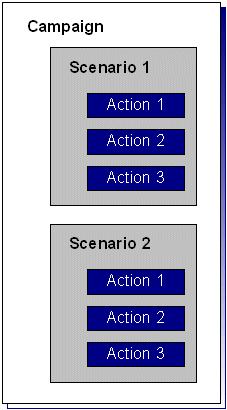
Specifying General Campaign Information
In addition to scenarios, campaigns also have some general information associated with them. You may have already considered this information during your strategic planning efforts, and perhaps you are ready to use this information when creating a campaign in the E-Business Control Center. Before using the E-Business Control Center to implement a campaign, however, be sure you have considered the following:
Campaign Attributes
Campaign attributes are simply some descriptive information about the campaign that can prove helpful to you when dealing with the campaign in the future. The E-Business Control Center requires that you specify the name of the campaign sponsor and a description of the campaign. Optionally, you can specify a goal description (value proposition) for the campaign, such as "to entice circular saw buyers to add saw blades to their cart before check out." All campaign attributes you specify can later be used as campaign search criteria.
Campaign sponsors are entities (that is, organizations) that have commissioned a campaign and on whose behalf the campaign is run. Often, the campaign sponsor will be the same as the organization who owns and operates the e-business Web site, or a department within that organization. However, the Web site owner may want to sell advertising on the site or enter into manufacturer or distributor sponsored campaigns. In such cases, the sponsor is different from the organization that owns the site. In the E-Business Control Center, the sponsor can be used as a criterion for campaign searches as well as for reporting and analysis purposes.
The name you choose when you save your promotional campaigns also has an effect on future campaign reporting. By applying a standardized naming convention across specific campaign fields you can further simplify the process of organizing and aggregating campaign data for inclusion in reports. For example, if you always begin your promotion names with campaign type (upsell, cross-sell, retention, and so on), you will be able to roll up or sort based on this standard.
For More Information
For more information about searching for campaigns, see Locating Existing Campaigns.
Campaign Duration and End Criteria
A campaign normally has a fixed duration, or period of time during which it is active. The E-Business Control Center will record your campaign's starting and ending date and time. For campaigns using scenarios with ad actions, however, the E-Business Control Center also provides you with another option: a campaign goal can be used to stop the campaign, prior to its scheduled end date. For example, the goal might be for a certain number of circular saw buyers to clickthrough an ad to another Web page that provides details about a saw blade discount. Or maybe you just want a certain number of people to see your ad (called an impression in the E-Business Control Center). In the E-Business Control Center, these goals are called campaign end criteria. When your goal is satisfied—that is, when the number of ad clickthroughs or impressions reaches the number you set—the campaign can end.
Customer Segments in Scenario Actions
The E-Business Control Center allows you to target customers for personalized content and messaging by creating dynamic groupings called customer segments. Every visitor may be evaluated during their session in your site or application to determine if they qualify for targeting as a member of one or more defined customer segments. In order to determine if a customer is a member of a given segment, each qualifying condition you specify is evaluated. Thus, a segment is a manageable way of bundling together two or more characteristics that represent a complex customer type.
When and When Not to Use Segments
You do not always have to use customer segments to target specific groups of people with campaign scenario actions. When creating a scenario action, instead of triggering the action on a customer segment, you can trigger the action if the visitor has certain characteristics—the same set of characteristics you can use to create a customer segment. So since you can trigger a scenario action on visitor characteristics with or without a customer segment, you should put some thought into whether or not you create customer segments.
In the following guidelines to determine whether or not you should create a customer segment for use in scenario actions, reuse is the key:
Order and Logic of Evaluation
Both scenarios and scenario actions can be targeted at segments. If segments are used in scenarios and its actions, the segments are evaluated as if they are connected with AND logic; that is, a customer must qualify as a member of both segments in order for the customer to be targeted in that campaign.
Usefulness of Chaining Segments
The logic of AND-ing segments means that you can use them to progressively narrow your targeting without having to script new, even more complex segments.
Cautionary Notes
Note that it is possible to target nobody by carelessly chaining the targeting of segments in a scenario and its actions.
A more likely case of this phenomenon would be one where very few users satisfied all the conditions of both the scenario segment and its action segments. Therefore, it is important to be familiar with the underlying conditions that make up your established segment definitions.
What if You Only Need to Target One Segment?
Where should you input your segment targeting (if any)—at the scenario level, or at the action level?
Typically it should be at the scenario level for the following reasons:
However, targeting segments at the action level is useful in some instances; for example, when you anticipate needing to add parallel actions within the same scenario later, but target those actions at different customer segments.
About Probability-Based Branching
Probability-based branching is a mechanism for dividing campaign scenario actions into proportional but random customer segments (subject to other conditions that may apply). Each time a scenario is evaluated to determine if any of its actions (ad, e-mail, or discount) apply to the customer, a random number between 1 and 100 is automatically generated by the system. If any action in the scenario includes a probability-based branching condition, then that number is used in its evaluation. If no scenario includes branching, then the number is forgotten, and a new random number is assigned for the next scenario in the campaign.
Branching is designed to provide two distinct capabilities:
Figure 9-2 Branching the Entire Population by Varying Percentages
Figure 9-3 Branching a Small Percentage of the Population, as a Test Case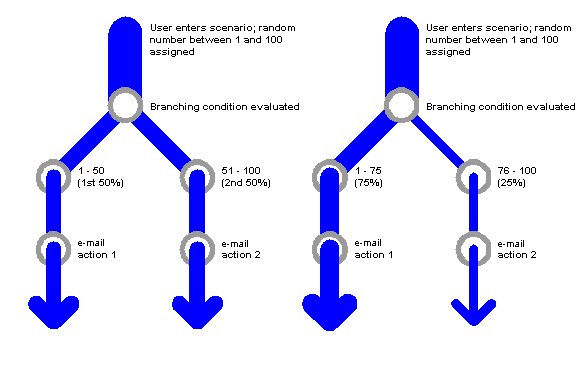
Note: It is important to keep in mind what the base of the branching condition is. Consider a branching condition set 50% (from 1 to 50). Will this condition filter its action to execute only for half your customers? Not necessarily.
First of all, remember that the 50% branch condition is only being evaluated for customers that visit the site. Secondly, active visitors may be further filtered by some customer segment targeting at the scenario level, and then again at the action level. So the final 50%, in some cases, may be a percent of a percent of a percent, and so on. (For more information about defining customer segments at the campaign and scenario levels, see Customer Segments in Scenario Actions.)
This is particularly important to keep in mind when using smaller branches (approximately 5%) for test marketing. Depending on customer segmentation, a 5% or 3% branch may target so few customers as to be statistically meaningless. Think through the targeting and branching so you reach a useful number of your user base.
Setting a Scenario to Run Just Once for a Visitor
Of particular use when branching actions for test marketing is the Once This Action Is Performed, Do Not Run The Scenario Again For This Visitor check box option, shown in the New Action windows (for ads, discounts, and e-mails). In the ordinary course of campaigns, each time a qualifying visitor comes to the site, that visitor can be targeted with whatever promotional messages (ads and/or e-mails) and discounts are active. However, you usually need mutually exclusive populations for valid market tests. Therefore, the E-Business Control Center provides the ability to have a scenario run once only per visitor. This feature is also pertinent in the case of e-mail campaigns. In many cases, you will want customers to receive only one copy of a given promotion via e-mail.
Authoring Campaign Messages
The E-Business Control Center allows you to use both ads and e-mails in scenario actions to convey promotional messages. If you choose either of these options, you must have previously authored these messages (much like you previously define discounts) and consider a few other factors before using them, as described in the following subsections:
Authoring Ads
An ad can be a graphic, a segment of HTML or plain text, or a file that is displayed by a Web browser plug-in. Before you can use an ad in your promotional campaign, you will first need to create and store it.
Placing Ads in Your Web Site
After you create and store your ads, you must determine which pages display the ads and where on those pages the ads are displayed.
Figure 9-4 Placeholder with a Campaign Query and a Default Query
After a graphic artist or ad developer creates and stores ads, a business analyst or business engineer creates the placeholders (names them and assigns queries to them) in the E-Business Control Center, and a developer puts the placeholders in the appropriate JSPs.
For More Information
Authoring E-mails
As part of a promotional campaign, you may decide to send an e-mail to specific customers. Before you can send e-mails, however, you will first need to:
Figure 9-5 Sample Promotional E-mail
Note: To ensure that the appropriate customer profile information is substituted into the message, you may need to collaborate with your business engineer or another member of your organization's technical staff to personalize your e-mails in this way.
For More Information
Defining Discounts
With WebLogic Portal, you can use discounts to help you realize your strategic business objective. For example, if your goal is to entice circular saw buyers in your hardware store to add saw blades to their cart, you might offer them a 50% discount on the saw blades.
To define discounts that are meaningful for your marketing efforts, you will need to consider the following:
For More Information
Warning: Because customer orders may be linked to discounts once they are deployed, you will not be able to modify or delete a discount until its associated time frame (duration) has expired or until it can be determined that no orders are linked to the discount. Therefore, it is extremely important that you define discounts appropriately.
Campaign Maintenance
When saving your campaigns, the E-Business Control Center will ask you to supply a campaign filename. You or others in your organization might find that establishing and following certain naming conventions for campaigns is useful. For example, campaign file naming conventions might help you tie together and therefore quickly locate related campaigns, or assist you when it comes time to run analytic reports. Filename conventions can also identify ownership among different users designing and working with campaigns.
You will also find it beneficial to write good descriptions for your campaigns. You might even use descriptions as a way to coordinate with other users of the E-Business Control Center. For example, you might want to include an author or contact name in the campaign description, so that others who see the campaign know who to contact if and when they have questions about that campaign.
Extending the Services That Support the E-Business Control Center
Out-of-the-box, the E-Business Control Center provides many elements you can use to create your own unique promotional campaigns. However, it is possible that you may want to extend the E-Business Control Center to more closely match your e-business needs. For example, the E-Business Control Center allows you to select from a number of predefined customer behaviors (events) to trigger scenario actions. If you think of an event that is not already available, you may want it to be created and added to the system. Customer profile information is another example; the system is extremely flexible in the data it can store about visitors to your Web site.
If you believe that extending the E-Business Control Center would be helpful, you will initially need to collaborate with a business engineer or other technical resource in your organization who can make modifications to the tool. If possible, you should initiate this process before proceeding with the E-Business Control Center.
For More Information
To determine what events are initially available for use in the E-Business Control Center, see "Creating and Managing Property Sets". However, keep in mind that if your organization extends the services that support the E-Business Control Center, you should use the E-Business Control Center itself to view the most up-to-date list.
Deciding on Campaign and Scenario Scope
The E-Business Control Center is so flexible that it may seem that there are always multiple ways to accomplish any one goal. And yet, you will learn that there are often preferred ways to use the tool, and to structure your campaigns, depending on factors such as:
Consider the following sets of campaigns (strategic), scenarios (tactical), and actions (operational), shown in Figure 9-6.
Figure 9-6 Campaign and Scenario Nesting Approaches
These three campaign approaches are apparently equivalent. Each approach will result in customers being recognized if they are members of one of three target segments, and being sent or displayed the appropriate content (that is, each approach satisfies an identical customer use case). However, each has pros and cons, even in this simple generic example. Approach A Figure 9-7 A Closer Look at Approach A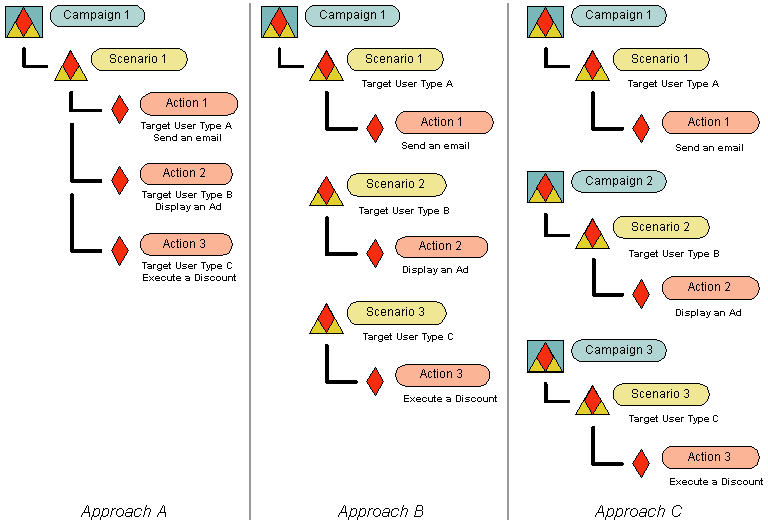
Approach A (shown again in Figure 9-7), where all actions are lumped into a single scenario in a single campaign, is best when: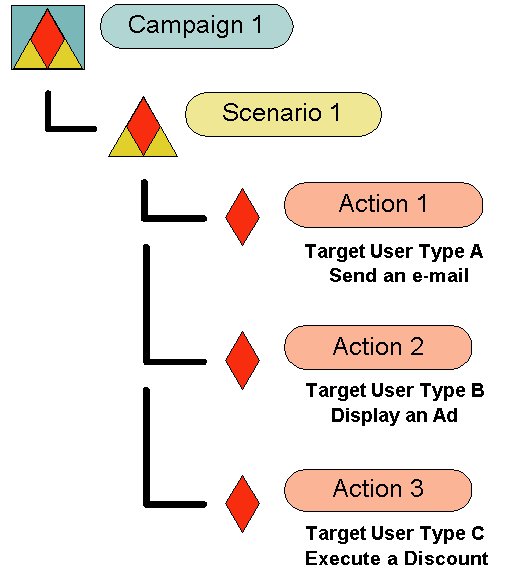
Approach A has drawbacks for the following situations:
Approach B
Figure 9-8 A Closer Look at Approach B
Consider Approach B (shown again in Figure 9-8), which puts each action into separate scenarios—but all within a single campaign—for the following case:
Approach C
Figure 9-9 A Closer Look at Approach C
Approach C (shown again in Figure 9-9), which breaks every action and scenario out into separate campaigns, is best in the following cases: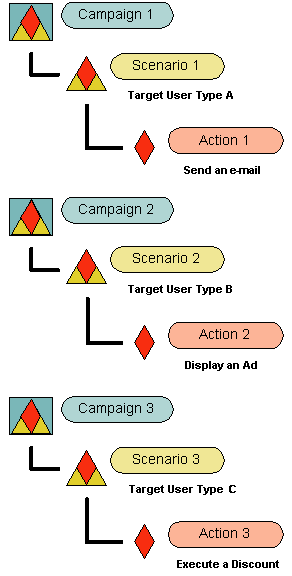
A Note About These Approaches
If you look again at Figure 9-6, you will see that Approaches A and B might represent any individual campaign, such as you will first create when you begin to use E-Business Control Center.
However, Approach C might resemble your collection of campaigns and scenarios after some time, when you have built and launched multiple campaigns. Each of the campaigns nested within Approach C can have a structure like that of Approach A or Approach B.
This observation suggests that new users of the E-Business Control Center proceed conservatively, dividing up campaigns according to their internal business processes and marketing programs, and reassess their practices periodically, trying to strike a balance that avoids either of these extremes:

|

|

|
|
|
|
Copyright © 2001 BEA Systems, Inc. All rights reserved.
|